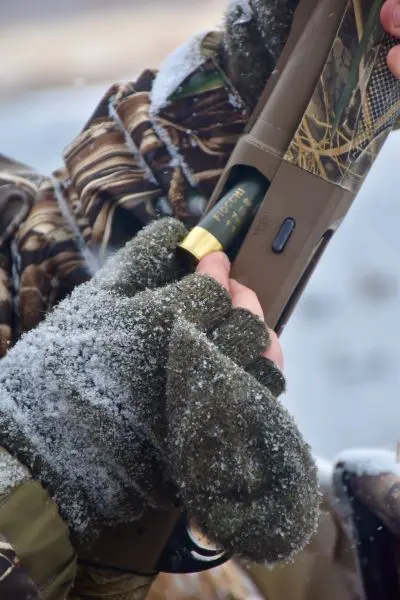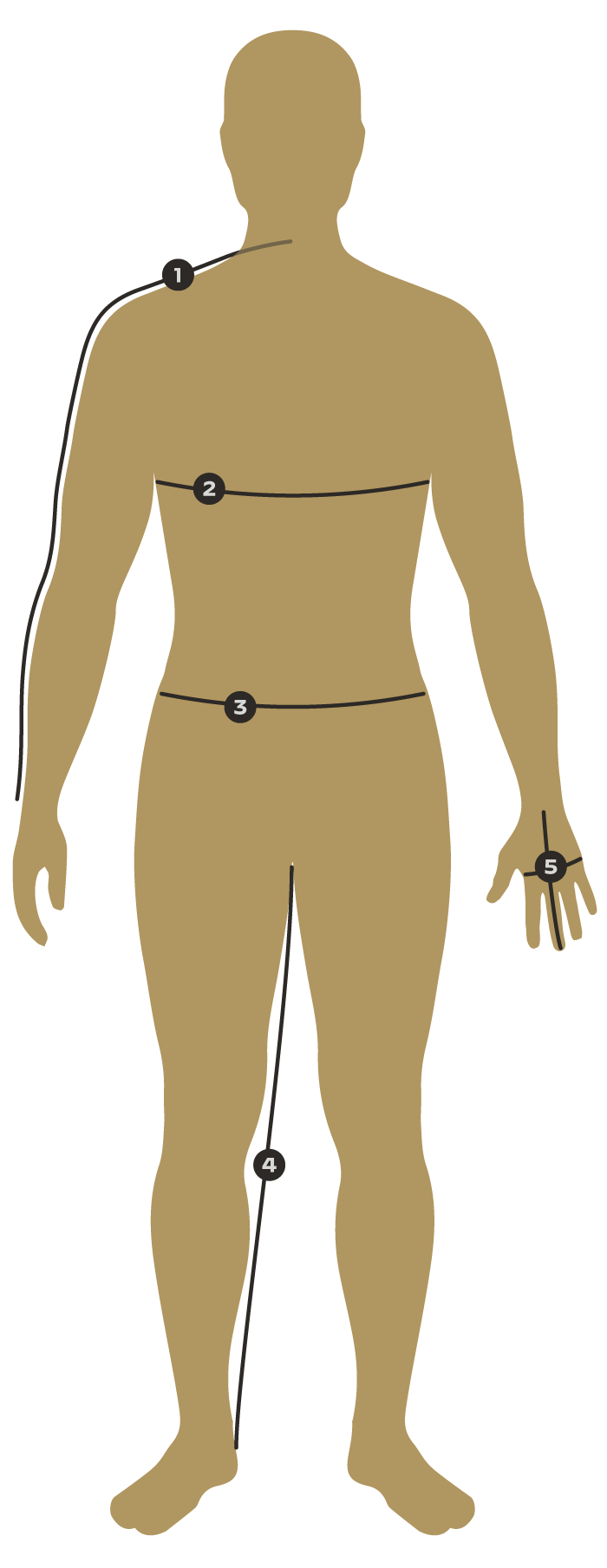The first duck I ever shot was on Johnson Lake when I was about 12. The drake bluebill folded at the report from my square-backed 20-gauge Remington Sportsman like it had run into a brick wall. It didn’t matter that I aimed at the lead scaup, and the third duck in line went down. I had borrowed the gun from my grandpa. It wasn’t the perfect waterfowl gun, but it served me well during my formative years of waterfowl hunting.
I don’t recall getting a different firearm until about five years later. I was scouring the newspaper ads and bugging and begging my dad to get me a shotgun. I saw an advertisement for a no-frills 12-gauge Winchester Model 1400 semi-auto shotgun at our local Yankee store. I distinctly remember the gun being on sale for $99. On Friday, payday, my dad took my brother, Pat, and me to the store and bought each of us a shotgun.
With the increased firepower, I was now on a mission. The Winchester was my do-it-all firearm. It was my duck gun when I hunted Saginaw Bay, and once at college, I waylaid plenty of grouse and pheasants with it, too. Once I graduated, got married, and got an apartment, someone broke in and stole the gun. I was disappointed, but by then, the gun certainly didn’t owe me anything.
I purchased a 12-gauge Remington 870 Wing Master pump. I remember giving $150 for the gun. It had a wood stock and forearm, which were quite nice back in the day before the wood on cheap guns resembled pallets. Even though the gun only accepted 2-3/4- inch shells, it performed well for me. I eventually upgraded to another Remington 870 with a synthetic camo stock and forearm that accepted 3-inch ammo. It was my go-to firearm for a long time, and I eventually purchased a similar backup.
During my tenure at Cabela’s, I attended SHOT Show and Media Day at The Range. For firearm enthusiasts, SHOT Show and Media Day at The Range was like dying and going to heaven. Every manufacturer was there with their new product coming out for the year. I distinctly remember shooting Beretta’s new A-400. I dusted the clays they were throwing and was amazed by the lack of recoil from the gun. It planted the seed that maybe it was time again for a semi-auto.
One of the best things about being an outdoor writer is the perks. It certainly isn’t the pay! Two decades ago, I was invited on a waterfowl hunting trip to Saskatchewan, which was sponsored by Benelli and Federal Ammunition. Benelli told me they were going to be sending me a firearm, and that I should bring it with me. Being it was only a 12- or 13-hour drive from Sidney, Nebraska to where we were meeting in Saskatchewan, I elected to drive, and it saved me the rigamarole of Denver traffic, checking a firearm plus I got to meander my way through Montana and hit a couple of my favorite spots in southern Saskatchewan on the way. The Benelli Super Vinci they sent me had just been introduced to the market. The only real difference between the Vinci and the Super Vinci was that the Super Vinci could shoot 3 1/2- inch ammo.
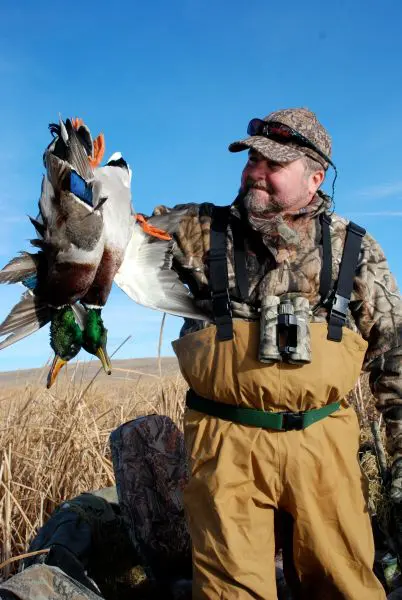
- Benelli’s VP of Marketing, Tim Joseph, with a pair of rake greenheads
Duck Creek Outfitters (duckcreekoutfitters.com) was not easy to find. The event occurred before every vehicle was equipped with GPS, and road signs were scarce and infrequent in rural Saskatchewan. I drove past the farmhouse once before realizing it was the lodge. Owner Sykes Mitchell greeted me and advised me that others in the party were en route. The interior of the place belied its demure exterior. Inside were impressive mounts of rams to waterfowl, a fieldstone fireplace, and aromas from the kitchen that made you feel right at home.
The hunting during the week took place over water and in fields and was exceptional. We had plenty of opportunities to test Stoeger and Benelli firearms with the Black Cloud ammunition provided. The guns performed flawlessly, and it was especially impressive to experience the minimal recoil they produced, as well as the fact that the revolutionary inertia-driven recoil technology eliminates gases that could potentially foul a gun’s operation. The absence of recoil was surreal.
Benelli’s Inertia-Driven System cycles the gun using inertia rather than gas, which makes it faster and less prone to fouling. Gases and powder go out of the barrel instead of back into the gun. Inertia-driven shotguns also tend to be simpler, lighter, slimmer, and more reliable with fewer moving parts. Combine this with Benelli innovations like ComforTech technology; recoil is almost non-existent. The technology utilizes comb inserts to cushion your cheek, shock-absorbing recoil pads to mute the recoil of magnum loads, and synthetic chevrons that flex and neutralize recoil. One criticism of the gun blogs is that inertia-driven systems may not function as well with lighter loads, which is inconsequential to waterfowlers.
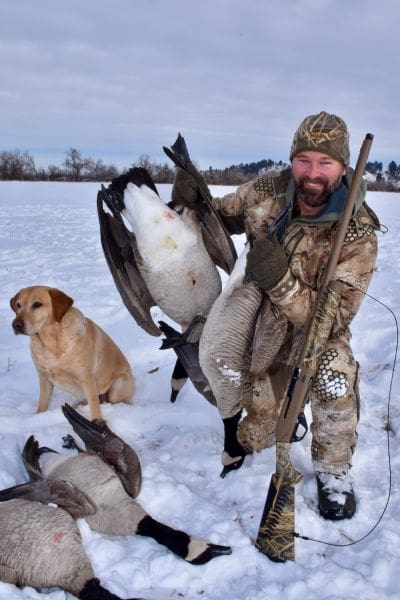
- Jacob Eaton used a Benelli SBE3 stroked with Fiocchi steel to harvest
At the end of the week, I asked who I should give the gun to. The response was, “Oh, that’s yours. Take it home.” The following week, I sold all my 870 Remington pump guns. The serial number on the Benelli is 0000018.
There are several features to consider when purchasing a waterfowl firearm. The most obvious is the action. “What action you choose is largely a matter of personal preference,” said Bret Maffett, senior product manager at Benelli USA. “Most people don’t want to take their over-and-under waterfowl hunting. Generally, doubles are high-end guns you wouldn’t want to take in the nasty conditions you generally encounter when waterfowl hunting. The only advantage of an over-and-under is the choke options. The advantage of a pump action is reliability. They’re simple and cost-effective but require a physical motion to operate. The reliability of semi-automatic actions these days makes that a moot point. Cost is the biggest driver.”
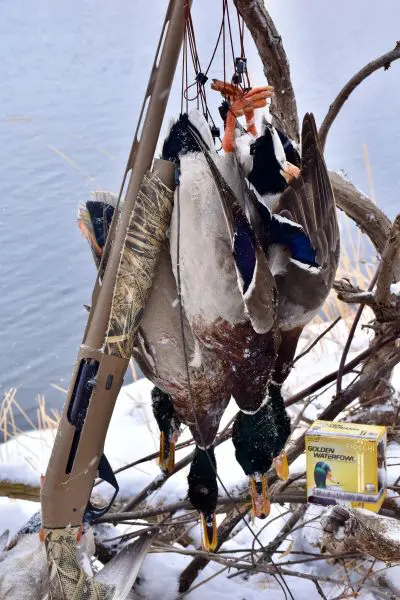
- The combination of a reliable shotgun and premium ammunition
On a trip to the Texas Gulf Coast, the guides used what we came to call Krylon pumps. The brackish waters there ate shotguns for lunch. Rather than try to maintain the shotgun’s pristine finish or hunting with a rusted club, the guides succumbed to the environment and gave their guns a spray paint coating when needed.
“Camouflage is great from a concealment standpoint,” said Maffett, “but some of the new finishes available today are an advantage when it comes to durability.”
New, modern-day finishes are much more resistant to rust. Cerokote is one option. Cerokote is a thin film of ceramic coating or treatment that offers superior protection from corrosion, abrasion, and extreme conditions. Cerokote isn’t just a finish or coating. It bonds at the molecular level, which offers improved durability and performance at a reasonable cost. The finish is especially attractive to waterfowl hunters who subject their firearms to adverse conditions and use. The non-glare finish adds to its appeal.
Benelli has stepped into the future with its proprietary BE.S.T. finishing technology. The hybrid Physical Vapor Deposition (PVD) and Plasma Enhanced Chemical Vapor Deposition (PECVD) technology is way beyond my pay grade. The technology has been used in many industries for years, but Benelli is the first to apply it to shotguns. Nanotechnology yields an exceptionally hard surface that is resistant to scratching and will never rust or corrode.
Maffett lives on a brackish creek in Virginia. Wanting to give the technology his personal field test, he put a BE.S.T-treated barrel in the water behind his house for three months. Upon retrieval, the barrel didn’t have a speck of rust.
Barrel length is a matter of contention and personal preference based on swing, balance, weight, and feel. “The most popular barrel length is 28 inches,” said Maffett. “The longer barrel length helps with swing, balance, and a longer sight plane. That’s one of the disadvantages of a double-barreled gun. With the shorter action of a double gun, the sight plane is shorter.”
While the 12-gauge is the most popular bore by far for waterfall hunting, other gauges are seeing a resurgence due to ammo options and effectiveness. “We’re seeing the three-inch 20-gauge becoming increasingly popular for waterfowling because of the better performance you can achieve with high-quality bismuth and tungsten ammo these days,” said Maffett. “There’s also the advantage of a lighter gun and ammo. If you’re hiking back into a remote location, a pound or two here and there can make a big difference without sacrificing much performance.”
Benelli Advanced Impact is a dynamic new barrel and choke system designed to generate more velocity, energy, and downrange penetration from shells. “Advanced Impact operates as a system,” said Maffett. “The combination of a contoured barrel, long forcing cone, and an extra-long choke tube results in 50 percent more penetration, shorter shot strings, improved patterns while retaining velocity. The result is more energy at impact.”
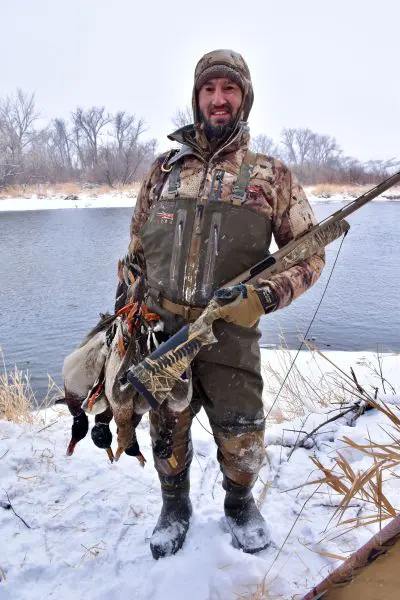
- Benelli Senior Product Manager Brett Maffett was happy with his Benelli
Last winter, I got to experience how game-changing Advanced Impact can be on a hunt in Montana. The first day, we hunted on the Big Horn River in a blizzard and 15-degree temperatures. The birds were decoying well, and I was initially more concerned about capturing images than shooting ducks. When my turn arose, the ducks and geese were in-your-face-close, and the Benelli Super Black Eagle 3 shotguns and Fiocchi Golden Waterfowl steel we were using performed flawlessly.
The next day, we traveled to the Yellowstone River to hunt in an adjacent field the birds had been using. The snow had quit, but the temperatures had dipped into the single digits. Ice flows crowded the river, and the geese were in no hurry to leave the roost. Three hours passed before someone shouted, “They’re in the air!” We all scrambled for our layout blinds.
I was comfortable in my Hardcore Extreme Parka, Bibs, Hammer Hi-Bird gloves, and Arctech fleece-lined hoodie, but I wasn’t the most mobile. I felt like the Pillsbury Dough Boy. Add to that the fact that I was the oldest in the group and wasn’t exactly “springing” from the layout blind. I was content with shooting images when the first pair of honkers decoyed, and a subsequent flock of Canadas committed suicide. No one needed any help. I decided to try shooting at the next gaggle of eight Canada geese that approached with wings locked. Birds were falling before I reached a sitting position. The shooting had stopped when I spied a goose that was hit but was going to go down hundreds of yards across the field. I put the SBE3 bead on the goose’s head and fired. “I don’t know who shot that wounded bird,” chortled the guide, “but that bird was out there!”
A similar incident happened shortly after. The survivors from a big flock that worked the spread perfectly were clawing for altitude. As usual, I was the last one shooting, and I swung ahead of a departing goose, which had to be 60 or 70 yards. The goose crumpled at the report from the SBE3 and the Fiocchi Golden Waterfowl BB steel load. I did not doubt that, were it not for the Advanced Impact technology, the honker would have escaped.
The ultimate waterfowling gun is a matter of conjecture. It comes down to getting the best gun you can afford, and remembering that it’s the singer, not the song.
